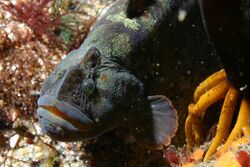Biology:Stichaeidae
| Stichaeidae | |
|---|---|

| |
| Arctic shanny (Sticheus punctatus) in Newfoundland | |

| |
| Cebidichthys violaceus | |
| Scientific classification | |
| Domain: | Eukaryota |
| Kingdom: | Animalia |
| Phylum: | Chordata |
| Class: | Actinopterygii |
| Order: | Scorpaeniformes |
| Suborder: | Zoarcoidei |
| Family: | Stichaeidae Gill, 1864[1] |
| Subfamilies[2] | |
|
see text | |
Stichaeidae, the pricklebacks or shannies, are a family of marine ray-finned fishes in the suborder Zoarcoidei of the order Scorpaeniformes. Most species are found in the North Pacific Ocean with a few in the North Atlantic Ocean.
Taxonomy
Stichaeidae was first proposed as a family in 1864 by the American zoologist Theodore Gill, although he called it the Stichaeoidae.[2] The 5th edition of Fishes of the World classifies this family within the suborder Zoarcoidei, within the order Scorpaeniformes.[3] Other authorities classify this family in the infraorder Zoarcales wihin the suborder Cottoidei of the Perciformes because removing the Scorpaeniformes from the Perciformes renders that taxon non monophyletic.[4]
Fishes of the World mentions six subfamilies but does not assign genera to the subfamilies[3] while other authorities split the Cebidichthyidae, Opisthocentridae, Lumpenidae and Neozoarcidae from the Sitchaeidae as valid families. The genera which are classified within the family Eulophiidae were also previously included within the Stichaeidae.[5][6][7][8][9][10]
Subfamilies and genera
The family Stichaeidae is classified into subfamilies and genera as follows († means extinct):[2]
Catalog of Fishes classifies these fishes as follows:[5][6][7][8][9][10]
Etymology
The name of the family comes from that of its type genus Stichaeus, which means “set in a row”, which may be an allusion to the row of black spots on the dorsal fins of the species in that genus.[12]
Characteristics
Stichaeidae are characterised by having elongate bodies which are a little compressed. They have a very long dorsal fin which typically contains a large number of sharp spines, giving rise to the common name of prickleback, and there may be some spines at the rear of the dorsal fin. The anal fin is long and has its origin closer to the head than to the tail, or halfway between the head and tail. The pectoral fins may be very small to very large and fan shaped, containing between 2 and 21 rays. The normally present small pelvic fins are located anterior to the pectoral fins, and have a single spine and between one and four rays. There are no appendages on the head, although some species have a crest, and there is a single pair of nostrils. The body is typically covered with small, overlapping scales but the head, other than the cheeks, is normally lacking scales. The sensory canals on the head are typically well developed; there are normally 6 preopercular pores and 4 mandibular pores. There may be two lateral lines which can vary from a hardly noticeable row of neuromasts to one or more canals which can have complex branching. Their teeth are small and may be incisor-like or conical in shape. In the majority of species the gill membranes are widely joined and separate from the isthmus. Most species have a siphon on the operculum. They usually have pyloric caeca but not a swim bladder. They have ribs.[2]
Distribution and habitat
Stichaeidae is found in the North Pacific, North Atlantic, and Arctic oceans, with the majority of species in the North Pacific. They are coastal fishes which are found beneath rocks and in algae from the intertidal zone to shallow bays. the can be found at depths greater than 250 m (820 ft) on the outer continental shelf.[2]
References
- ↑ Richard van der Laan; William N. Eschmeyer; Ronald Fricke (2014). "Family-group names of Recent fishes". Zootaxa 3882 (2): 001–230. doi:10.11646/zootaxa.3882.1.1. PMID 25543675. https://www.researchgate.net/publication/268078514.
- ↑ 2.0 2.1 2.2 2.3 2.4 Mecklenburg, C. W.; B. A. Sheiko (2004). "Family Stichaeidae Gill 1864 — pricklebacks". California Academy of Sciences Annotated Checklists of Fishes 35. https://www.calacademy.org/sites/default/files/assets/docs/stichaeidae.pdf.
- ↑ 3.0 3.1 J. S. Nelson; T. C. Grande; M. V. H. Wilson (2016). Fishes of the World (5th ed.). Wiley. pp. 478–482. ISBN 978-1-118-34233-6. https://sites.google.com/site/fotw5th/.
- ↑ Ricardo Betancur-R; Edward O. Wiley; Gloria Arratia et al. (2017). "Phylogenetic classification of bony fishes". BMC Evolutionary Biology 17 (162): 162. doi:10.1186/s12862-017-0958-3. PMID 28683774.
- ↑ 5.0 5.1 Eschmeyer, William N.; Fricke, Ron; van der Laan, Richard, eds. "Genera in the family Stichaeidae". California Academy of Sciences. http://researcharchive.calacademy.org/research/ichthyology/catalog/fishcatget.asp?tbl=genus&family=Stichaeidae.
- ↑ 6.0 6.1 Eschmeyer, William N.; Fricke, Ron; van der Laan, Richard, eds. "Genera in the family Lumpenidae". California Academy of Sciences. http://researcharchive.calacademy.org/research/ichthyology/catalog/fishcatget.asp?tbl=genus&family=Lumpenidae.
- ↑ 7.0 7.1 Eschmeyer, William N.; Fricke, Ron; van der Laan, Richard, eds. "Genera in the family Neozoarcidae". California Academy of Sciences. http://researcharchive.calacademy.org/research/ichthyology/catalog/fishcatget.asp?tbl=genus&family=Neozoarcidae.
- ↑ 8.0 8.1 Eschmeyer, William N.; Fricke, Ron; van der Laan, Richard, eds. "Genera in the family Eulophiidae". California Academy of Sciences. http://researcharchive.calacademy.org/research/ichthyology/catalog/fishcatget.asp?tbl=genus&family=Eulophiidae.
- ↑ 9.0 9.1 Eschmeyer, William N.; Fricke, Ron; van der Laan, Richard, eds. "Genera in the family Opisthocentridae". California Academy of Sciences. http://researcharchive.calacademy.org/research/ichthyology/catalog/fishcatget.asp?tbl=genus&family=Opisthocentridae.
- ↑ 10.0 10.1 Eschmeyer, William N.; Fricke, Ron; van der Laan, Richard, eds. "Genera in the family Cebidichthyidae". California Academy of Sciences. http://researcharchive.calacademy.org/research/ichthyology/catalog/fishcatget.asp?tbl=genus&family=Cebidichthyidae.
- ↑ Mikhail Valerievich Nazarkin (1998). "New Stichaeid Fishes (Stichaeidae, Perciformes) from Miocene of Sakhalin". Journal of Ichthyology 38 (4): 279–291. https://www.researchgate.net/publication/273761112.
- ↑ Christopher Scharpf; Kenneth J. Lazara, eds (4 July 2021). "Order Perciformes (Part 11): Suborder Cottoidea: Infraorder Zoarcales: Families: Anarhichadidae, Neozoarcidae, Eulophias, Stichaeidae, Lumpenidae, Ophistocentridae, Pholidae, Ptilichthyidae, Zaproridae, Cryptacanthodidae, Cebidichthyidae, Scytalinidae and Bathymasteridae". The ETYFish Project Fish Name Etymology Database. Christopher Scharpf and Kenneth J. Lazara. http://etyfish.org/perciformes15/.
- "Stichaeidae". Integrated Taxonomic Information System. https://www.itis.gov/servlet/SingleRpt/SingleRpt?search_topic=TSN&search_value=171554. Retrieved 25 March 2006.
Wikidata ☰ Q1542021 entry
 |

